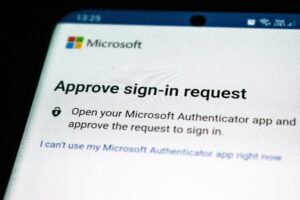
Contact Us Today!
Follow us on LinkedIn.
Introduction
In today’s digital landscape, where cyber threats are rising, ensuring the security of our online accounts and sensitive information is paramount. One of the most effective ways to fortify our defenses is through multi-factor authentication (MFA). With the ever-evolving sophistication of cybercriminals, relying solely on passwords is no longer sufficient. In this blog post, we will explore the concept of multi-factor authentication and its significance in safeguarding our digital world.
What is Multi-Factor Authentication?
Multi-factor authentication is a security measure beyond traditional username and password combinations. It adds a layer of verification, requiring users to provide multiple pieces of evidence to prove their identity. These factors fall into three categories: something you know, something you have, and something you are.
- Something You Know: This refers to knowledge-based factors, such as passwords, PINs, or answers to security questions. It is the most common form of authentication but is often vulnerable to hacking or phishing attacks.
- Something You Have: This factor involves possessing a physical item, such as a security token, smart card, or mobile device. It provides an extra layer of security because an attacker would need both your password and the physical item to gain access.
- Something You Are: This factor relates to biometric information, including fingerprints, facial recognition, or iris scans. Biometrics offers a highly personalized and secure means of authentication since they are unique to each individual.
How Does Multi-Factor Authentication Work?
Implementing MFA typically involves a combination of two or more of the factors above. When logging into an account, the user is prompted to provide the primary authentication factor, usually a password. Afterward, the system requests an additional verification form, such as a code sent via SMS, a fingerprint scan, or approval from an authentication app on their mobile device.
The Importance of Multi-Factor Authentication
- Enhanced Security: By adding multiple layers of authentication, MFA significantly reduces the risk of unauthorized access to accounts. Even if an attacker obtains a user’s password, they still need additional factors to gain entry.
- Protection against Data Breaches: In a data breach where passwords are compromised, having MFA ensures that the stolen credentials alone are insufficient for accessing an account.
- Mitigating Phishing and Social Engineering Attacks: MFA helps combat phishing attacks by requiring an additional form of authentication, making it more challenging for attackers to trick users into divulging their login credentials.
- Compliance with Industry Standards: Various industries and regulatory bodies, such as healthcare, finance, and government sectors, mandate using multi-factor authentication to meet security requirements and protect sensitive information.
Best Practices for Implementing Multi-Factor Authentication
- Educate Users: Provide clear instructions on how to set up and use MFA, emphasizing its importance in safeguarding accounts and sensitive data. Offer training sessions and resources to ensure users understand the process.
- Choose Reliable Authentication Methods: Select reputable, robust authentication methods that meet your security needs. Consider user convenience, scalability, and compatibility with different platforms and devices.
- Employ Adaptive Authentication: Utilize adaptive authentication systems that assess risk levels and adjust the authentication process accordingly. This approach allows for a more seamless user experience while maintaining high security.
- Regularly Review and Update Security Measures: Stay proactive by monitoring advancements in authentication technology and updating your systems accordingly. Regularly review access logs, analyze potential vulnerabilities, and make necessary adjustments to optimize security.
Conclusion
Multi-factor authentication is a powerful defense mechanism in the face of evolving cyber threats. Combining various factors provides an extra layer of security that significantly reduces the risk of unauthorized access to online accounts and sensitive data. As individuals and organizations strive to protect their digital presence, implementing MFA is crucial to enhancing security and safeguarding our digital world.



